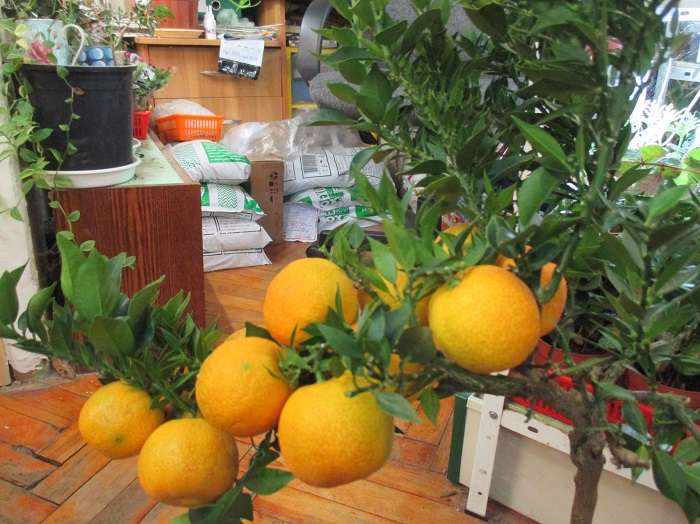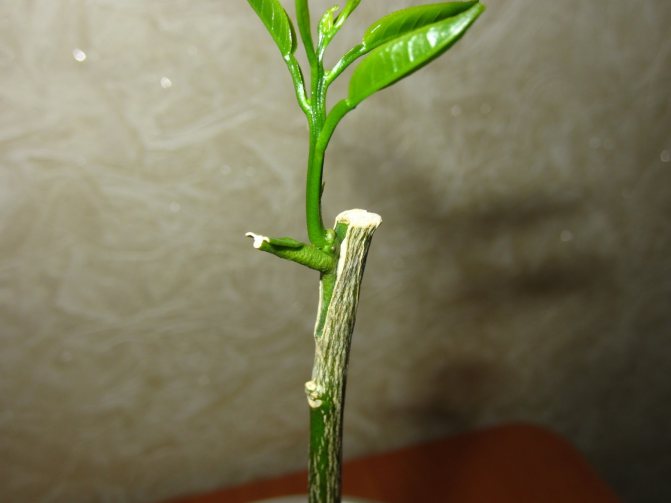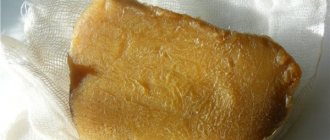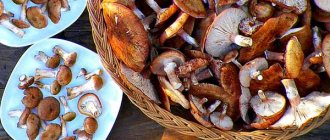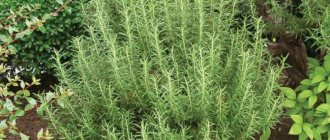2
4696
To understand how to plant a lemon at home, you need to study all the subtleties of the process. Plant grafting is a vegetative propagation method that is actively used in horticulture. Thanks to such manipulations, fruit crops begin to bloom faster and give a bountiful harvest.
Homemade lemons
The advantages and disadvantages of this breeding method
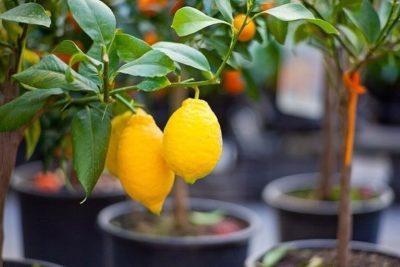
The main positive effect of grafting is the fruiting rate of the tree. For vaccination, you can use any of the known methods, but some of them will not allow you to make a second attempt. For example, a graft that has not taken root in the split will render the stock unusable and will have to be re-grown.
For some, the search for a high-quality rootstock can cause certain difficulties, because not all oranges and lemons grow at home. It is worth noting that self-grown lemon at home will be an environmentally friendly product, which you can eat without fear for your health.
Experienced gardening tips
Several recommendations from gardeners on how to get fruit from seed-grown lemon:
- Do not waste time waiting for the fruit, the lemon must be grafted.
- Plants no older than 3 years are suitable for the stock.
- Take material from already fruiting trees of a good variety.
- For the first 1.5 months, create a greenhouse effect for the lemon.
- Protect the tree from drafts and sudden temperature fluctuations.
- When budding, make several inoculations on different sites.
Be sure to remove the shoots on the rootstock branch as soon as they appear.
Selection and preparation of cutting and rootstock
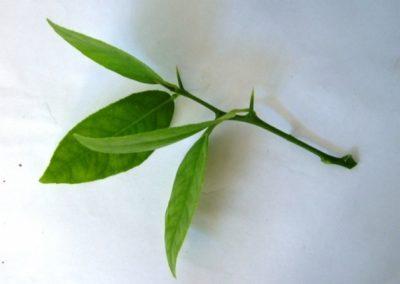

The graft must be selected from a fruiting tree, wrap it with a damp cloth after cutting and store in the refrigerator, and since long-term storage will lead to damage to the cutting, its darkening and rotting, the branch must be cut off immediately before the procedure.
The stock must be a strong and healthy tree., you can use a plant grown from a seed. The age for the operation of such a plant is considered optimal when it reaches 1-2 years. A young plant may not withstand the operation, and the old one will take longer to take root.
Required tools
To plant a homemade citrus, you need to prepare a well-sharpened small scalpel or an eyepiece knife, insulation tape or garden bandage to fix the rootstock with a scion, as well as a garden var. The latter will need to lubricate the cut of the tree so that the infection does not get there and it heals normally. For self-preparation of such a solution, take 100 g of pine resin, 25 g of wax and 20 ml of alcohol, mix and heat. Shoots in places of future cuts are wiped with wet wipes.
Step-by-step instructions for the procedure at home
There are many different ways to vaccinate lemon, all of which have their own advantages and certain disadvantages. It is important to understand the nuances of each procedure and choose the best one for yourself.
Copulation method
This method of grafting lemon is convenient with the same diameter of the stem of the motherboard and the scion. Due to this, growth and deformation of the trunk are not formed during fusion. To perform this operation, you must:
- Choose the same thickness rootstock and lemon scion.
- On each of them, the same oblique cuts are made with a sharp knife.
- Attach the stalk to the stock with a cut and wrap it tightly with polyethylene, eliminating any lagging of parts from each other and good adhesion.
Slices with such an inoculation should clearly fall on top of each other. If you do not fasten the branch tightly, then the parts of the plant will not grow together. The bandage is removed only when the kidneys begin to come to life on the handle, which means that the vaccination was a success.
Budding method
Eye grafting or budding is fairly straightforward, but requires a firm hand and precise cuts in the bark of the mother tree. If the vaccination is performed in spring or early summer, then an awakened kidney will do, but it is better to perform the operation in August with a sleeping one. To perform budding, you will need:
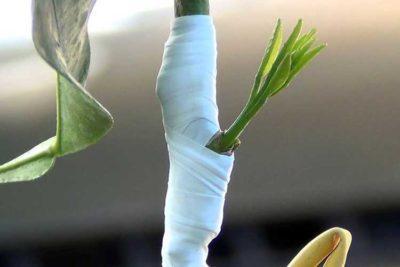

A peephole is cut off on a scion with a small supply of tissue up and down, with a total length of up to 3 cm. Part of the wood must be cut off together with the bud, the so-called "shield".- It is better to choose a place on the motherboard lower, to the first bud on the plant, make a T-shaped incision in the bark with a sharp instrument. The incision should be no more than 3 cm in length, and the horizontal incision should not be more than 1 cm. The incisions should only cut the bark without damaging the stem of the lemon.
- The cut peephole is inserted into the resulting incision on the stem of the lemon (rootstock), while the bark is gently pushed to the sides. Pressing the eye tightly will help to touch the cambial layers of the plants.
- After that, the vaccine is wrapped in a strong bandage. You can use a bandage, electrical tape, polyethylene. It is better to apply the electrical tape with a sticky layer outward, so that the bark of the tree will not be damaged. At the same time, the kidney remains outside, the bandage is applied to the sides of it.
- After dressing, the kidney should be treated with garden varnish.
If budding is successful, then after a month you can remove the bandage. The upper part of the stock is cut off, processed with garden varnish, for the possibility of developing a new bud.
What is the correct cleavage vaccination?
The method of such a vaccination is quite simple, but failure will result in the fact that the motherboard will no longer grow. To inoculate a lemon in a split, it is necessary to do:
- The stock is trimmed, leaving about 10 cm from the ground.
- With a sharp knife, a vertical section of the trunk is made to a depth of 3 cm.
- The stalk should have up to 5 healthy buds, the bottom of the branch is cut like a wedge on both sides. The length of the slices should be no more than 3 cm.
- The twig is inserted into the cut in the tree. If the scion is smaller or larger in diameter than the rootstock, then it is necessary to align the joint along one edge. When the motherboard is large enough and the trunk allows, then two cuttings can be grafted at once.
- Everything is wrapped tightly with polyethylene, and on top it is covered with garden varnish or plasticine.
This method is considered quite easy and is suitable even for inexperienced gardeners.
Cuttings for bark
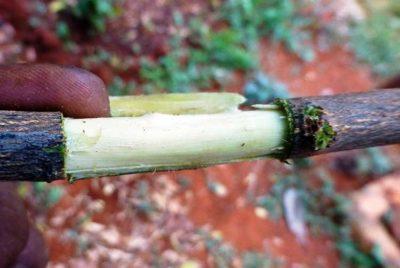

Bark grafting can only be performed when the mother tree is significantly thicker than the scion. The operation is performed in the following way:
- The rootstock is shortened to its full length, leaving only 7 cm from the ground.
- On one side, a 3 cm vertical incision is made with a sharp knife.
- An oblique cut of the same length is made on the handle.
- The bark of the tree is folded back and the stalk is inserted with a cut into the tree under the bark. If the tree is thick enough, then several cuttings are grafted at once in this way.
- The vaccination site is wrapped in a strong bandage and smeared with garden varnish.
Below the grafting, you can wrap the tree with a damp cloth - this will improve the survival of the cutting. Wrapping this place with a package will create a mini greenhouse. If shoots appear below the grafting, then they should be removed, otherwise all the work will be in vain.
Growing citrus fruits
The homeland of lemon is subtropical forests, where it grows wild. For many centuries, people have tried to spread it on the lands of Europe.The twentieth century was marked by the experiments of geneticists. Scientists have done a good job at breeding varieties that bear fruit well in northern latitudes and in indoor conditions.
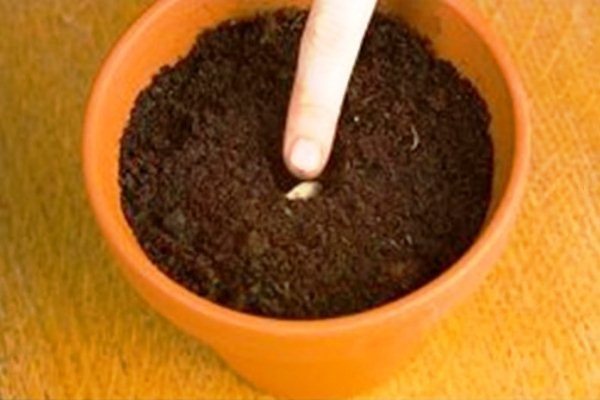

Seeds are used only freshly harvested. They are selected from ripe fruits that do not show signs of disease. Purely theoretically, this is so, but lemons come to us from supermarkets and bazaars.
Such fruits are definitely not freshly picked. How to be? Seeds that have dried up and have lain for a month at room temperature lose their germination significantly, but nevertheless germinate.
To grow a lemon at home one hundred percent, you need to stock not one or two seeds, but a lot more. Of a dozen seeds, there will definitely be several sprouts.
Don't be afraid to grow many seedlings at once. It is not a fact that all your seed lemons at home will live to fruition. Some will die from disease, others will suffer when you vaccinate them.
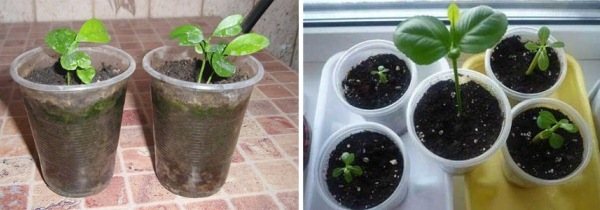

We start growing homemade pitted lemon as follows:
- We buy special soil or prepare the soil ourselves from river sand, turf soil, humus.
- We lay out the prepared soil mixture in separate small pots or cups.
- We plant the seeds in moist soil to a depth of 3 cm.
- Cover with foil on top to create a better microclimate.
- We are waiting for the sprouts to appear, which appear in about 3 weeks.
- If 2 shoots grow from one lemon seed, one (which is weaker) should be removed.
Growing citrus in this way is the easiest and most reliable option at home. Many gardeners have decorative lemon at home, many have waited for their fruiting. It should be noted that homemade tangerines are grown in the same way.
Citrus plants obtained from seeds adapt to indoor conditions better, turn out to be more hardy and viable compared to cuttings or grafted ones. Fully fruiting cultivated seedlings grow from the seeds. Their only drawback is that they start to bear fruit late.
Features of reproduction in the open field
In the open field, lemon propagation by rooting cuttings... A heat-loving plant requires insulation for the winter period, it does not tolerate severe frosts and is quite demanding on soil moisture.
For outdoor cultivation, cuttings cut from a tree are placed in a growth stimulator for 12 hours, then planted in a moist soil-sand mixture. Covered with foil, they should be warm on a sunny windowsill.
The plant loves spraying and regular watering. After rooting, the seedlings are transplanted into a nutritious soil, and they will be ready for transfer to the street in 2 years.
How to understand if the procedure was successful
If the stalk or bud during the first 5-7 days after inoculation retains freshness and elasticity, they have not darkened or dried out, it means that the grafting has been carried out correctly, they are alive, and then everything depends on caring for the plant.
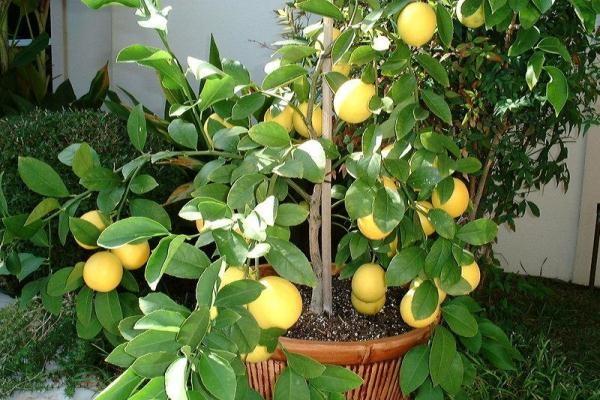

If the operation is unsuccessful, you need to give the plant a rest, and repeat it in a month. Today in flower shops you can find already grafted lemon seedlings, but growers try to grow it on their own, since purchased plants often die shortly after purchase.
Of course, vaccination on lemon requires knowledge and skills, but if you carefully study the subject and do everything carefully, the chances of success are noticeably increased - in 2-3 years fruiting will begin, and the pet will delight the owner with the first harvest to the envy of friends and acquaintances.
How to care for a lemon tree at first?
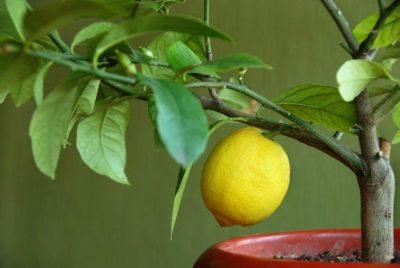

There are some peculiarities of the technique of looking after the lemon after the vaccination.:
- compulsory airing and spraying of the plant, every 2 days: first open, hold the lemon in the air for a few minutes, then spray and close again;
- the lemon should be warm, but not in the sun;
- fertilizers should be postponed for 3 months;
- it is better to cover the plant with a large plastic container, drowning it a little into the ground, so the effect of a bath will turn out, which will help the graft to take root better;
- after the appearance of the escape, continue all procedures;
- if a flower grows instead of a leaf, then it must be removed;
- all shoots below the graft must be removed;
- after a month, remove the bandage, but continue to cover the plant;
- after 1.5-2 months, when the vaccination gets stronger, you can remove the bath for a longer time, in 7 days you should completely open the lemon and leave it without shelter.
If the leaves of the plant turn yellow after opening, then it is too early, you should urgently spray the plant and cover again.
What is the lemon vaccine for?
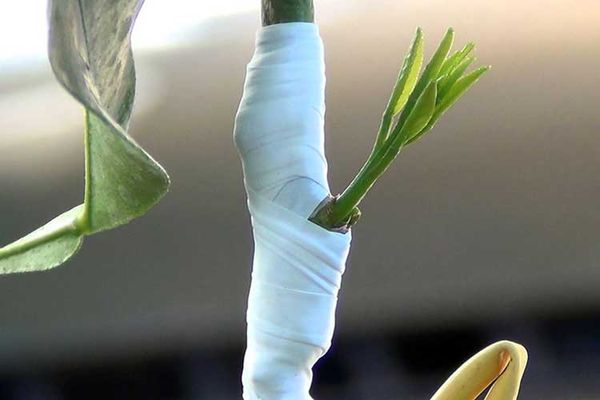

Grafting is the process of moving buds or shoots from one crop to another in order to grow together. Spring is considered the optimal time for the procedure.
Grafting a homemade lemon tree is necessary in order for it to begin bearing fruit faster. Even on the branches, varietal fruits will ripen, which will be of high quality, and not hybrid without transferring their properties to "descendants", as in the case of growing from seeds. It is possible to plant indoor lemon on a cultivated orange or other citrus plant.
What if it doesn't take root?
Depending on the method of grafting, the mother plant will either die or you can try again the next year. In general, the stalk does not take root in two cases.:
- Incorrectly performed vaccination operation, disinfection conditions were not met, the motherboard turned out to be weak for inoculation, the operation was slowly performed and the sections dried out, a poor-quality graft was selected, improper care.
- The mother is unable to accept the scion. Such cases are quite rare. But they also happen and occupy no less than 10% of all cases according to statistics.
You can change the method of vaccination the next year or take another graft, so it will turn out to understand what the mistake is.
Lemon grafting is not a complicated procedure, but it speeds up the possibility of growing fresh and natural citrus fruits on your site. Accurate implementation of all recommendations and strict adherence to instructions will allow you to quickly get the first harvest.
If you find an error, please select a piece of text and press Ctrl + Enter.
We plant the tangerine correctly
First of all, you need to prepare the planting material - a tangerine seed. It is best to immediately plant about ten seeds so that your efforts are suddenly not in vain. For planting, seeds obtained from ripe fruits are suitable. You can give the fruit a little overripe so that the seeds are definitely ready for planting and further growth. But don't let the tangerine rot, it can be bad for the seeds too.
Important. It is necessary to get seeds from the pulp immediately before planting, dried seeds are no longer suitable.
The already swollen mandarin seeds are planted in the ground.
Take a saucer, cheesecloth, or cotton wool. Pour warm water on the bottom of the dishes, put the material on top, let it soak in moisture, and put tangerine seeds on top, cover them with the same wet cloth or cotton wool. When the bones are very swollen, they can already be planted in the ground. When you see green growth, it's time to send tangerine crumbs to the ground.
Any commercial citrus soil or just a light nutritious substrate is suitable for planting. You can also prepare the soil yourself, for this you need to take from one part of leafy land, sod land and compost.
Sprouted seeds are best placed in a greenhouse - for this, good drainage is made in a spacious pot, soil is poured and plants are planted.The greenhouse should be placed in a bright place in the house, but not in direct sunlight, you can additionally illuminate the seedlings with a lamp. It is also necessary to regularly ventilate the greenhouse to prevent rot and mold. With a harmonious ratio of light, moisture and heat, the mandarin will grow quickly and will require a separate pot.



